- Joined
- Feb 2, 2011
- Messages
- 2,150
NEW RELEASES FOR DECEMBER 2020
THE CONQUEST OF AMERICA
THE AZTEC EMPIRE
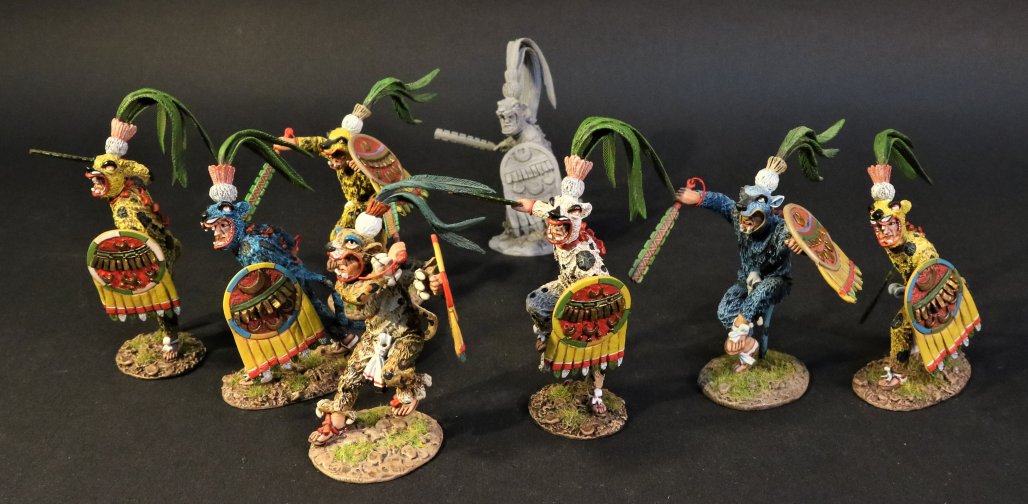
The Aztec Empire flourished between c. 1345 and 1521 and, at its greatest extent, covered most of northern Mesoamerica. Aztec warriors were able to dominate their neighbouring states and permit rulers such as Motecuhzoma II to impose Aztec ideals and religion across Mexico. Highly accomplished in agriculture and trade, the last of the great Mesoamerican civilizations was also noted for its art and architecture which ranks amongst the finest ever produced on the continent.
The empire continued to expand from 1430 and the Aztec military - bolstered by conscription of all adult males, men supplied from allied and conquered states, and such elite groups as the Eagle and Jaguar warriors - swept aside their rivals. Aztec warriors wore padded cotton armour, carried a wooden or reed shield covered in hide, and wielded weapons such as a super sharp obsidian sword-club (macuahuitl), a spear or dart thrower (atlatl), and bow and arrows. Elite warriors also wore spectacular feathered and animal skin costumes and headdresses to signify their rank. Battles were concentrated in or around major cities and when these fell the victors claimed the whole surrounding territory. Regular tributes were extracted and captives were taken back to Tenochtitlan for ritual sacrifice. In this way the Aztec empire came to cover most of northern Mexico, an area of some 135,000 square kilometres.
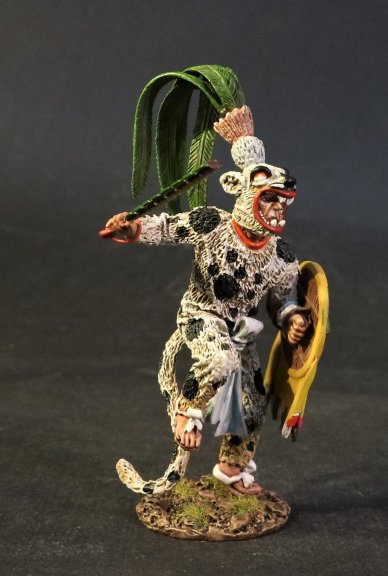
AZ-30A
THE CONQUEST OF AMERICA,
THE AZTEC EMPIRE,
AZTEC JAGUAR WARRIOR,
(1pc)
The War suit, called an OCELOTOTEC, was woven to resemble an animal skin.
In the case of noblemen, this was made from feathers.
Men of non-noble birth attaining the rank of Jaguar warrior, usually had to make do with suits made from actual skins. These usually had the clawed paws around the wrists and ankles.
Otherwise Jaguar War Suits came in a variety of colours, mainly blue , but also yellow , red and white.
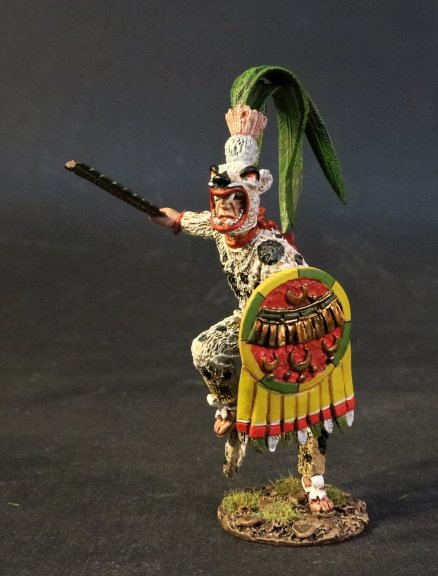
In most armies uniforms are used to differentiate units. In the Aztec army uniforms served to differentiate men with different levels of military experience within the same unit.
Rank descriptions in uniforms between warriors depended on how many captives each individual head taken. A soldier who succeeded in capturing four of the enemy was awarded a Jaguar suit and helmet.
It was believed that to capture an enemy, honored their gods in a way far greater than killing enemy soldiers in the battlefield. For a warrior to kill an enemy was considered clumsy.
The captured prisoners were offered as a sacrifice to the Aztec gods.
The jaguar motif was used due to the belief that the jaguar represented Tezcatlipoca, god of the night sky. Aztecs also wore these dresses at war because they believed the animal's strengths would be given to them during battles
Following the warrior's path was one of the few ways to change one's social status in Aztec culture. Eagle and Jaguar warriors were full-time warriors who worked for the city-state to protect merchants and the city itself. They were expected to be leaders and commanders both on and off the battlefield, and acted as sort of a police force for the city. Men who reached this rank were considered as nobles and elites of society, and were granted many of the same privileges as a noble.
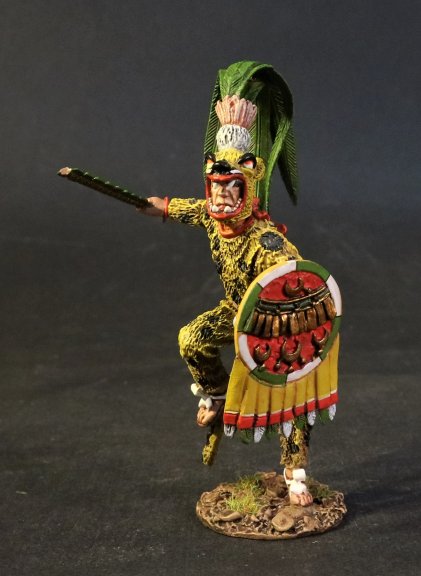
AZ-30B
THE CONQUEST OF AMERICA,
THE AZTEC EMPIRE,
AZTEC JAGUAR WARRIOR,
(1pc)
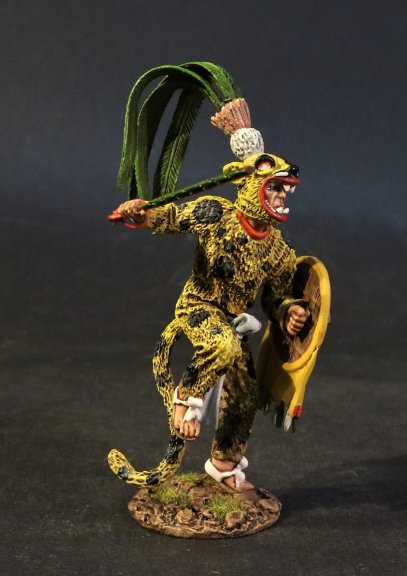
SPANISH CONQUISTADORS
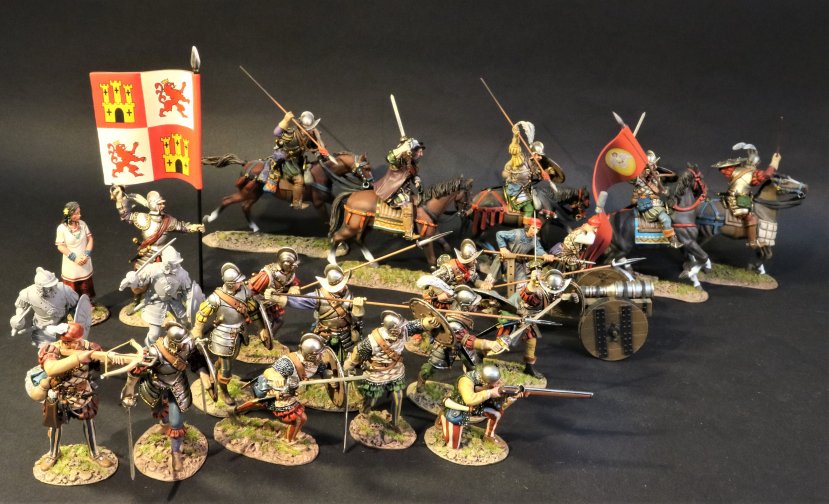
From the moment of Christopher Columbus' discovery of lands previously unknown to Europe in
1492, the New World captured the imagination of European adventurers. Thousands of men came
to the New World to seek fortune, glory, and land. For two centuries, these men explored the New
World, conquering any native people they came across in the name of the King of Spain (and the
hope of gold). They came to be known as the Conquistadors.
Hernán Cortés
Don Hernán Cortés de Monroy y Pizarro Altamirano, Marquis of the Valley of Oaxaca (1485 – December 2, 1547) was a Spanish Conquistador who led an expedition that caused the fall of the Aztec Empire and brought large portions of what is now mainland Mexico under the rule of the King of Castile in the early 16th century. Cortés was part of the generation of Spanish colonizers who began the first phase of the Spanish colonization of the Americas.
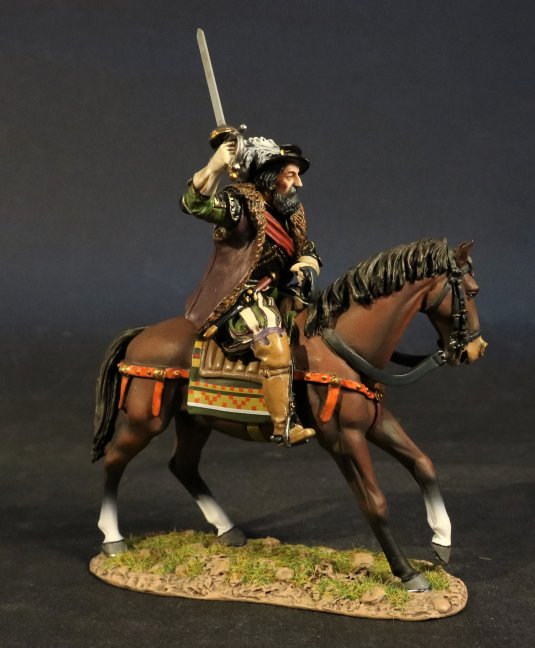
CQH-01
THE CONQUEST OF AMERICA,
SPANISH CONQUISTADORS,
HERNAN CORTES.
(2 pcs)
Born in Medellín, Spain, to a family of lesser nobility, Cortés chose to pursue adventure and riches in the New World. He went to Hispaniola and later to Cuba, where he received an encomienda (the right to the labor of certain subjects). For a short time, he served as alcalde (magistrate) of the second Spanish town founded on the island. In 1519, he was elected captain of the third expedition to the mainland, which he partly funded. His enmity with the Governor of Cuba, Diego Velázquez de Cuéllar, resulted in the recall of the expedition at the last moment, an order which Cortés ignored.
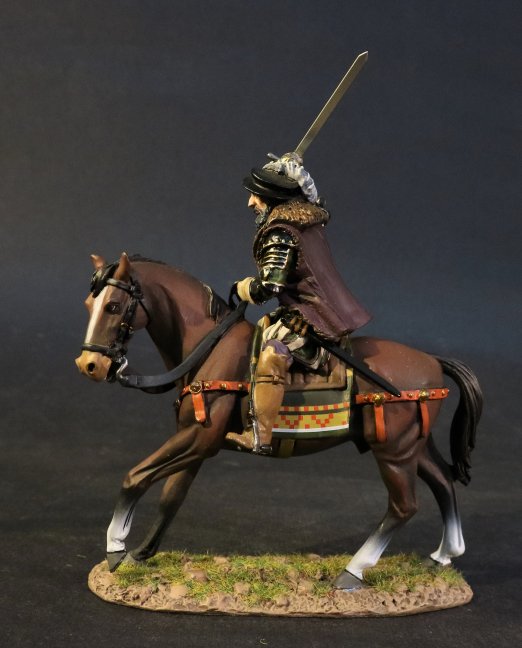
Arriving on the continent, Cortés executed a successful strategy of allying with some indigenous people against others. He also used a native woman, Doña Marina, as an interpreter. She later bore his first son. When the Governor of Cuba sent emissaries to arrest Cortés, he fought them and won, using the extra troops as reinforcements. Cortés wrote letters directly to the king asking to be acknowledged for his successes instead of being punished for mutiny. After he overthrew the Aztec Empire, Cortés was awarded the title of Marqués del Valle de Oaxaca, while the more prestigious title of Viceroy was given to a high-ranking nobleman, Antonio de Mendoza. In 1541 Cortés returned to Spain, where he died six years later of natural causes but embittered.
** PLEASE CONTACT YOUR LOCAL DEALER FOR FURTHER INFORMATION **
THE CONQUEST OF AMERICA
THE AZTEC EMPIRE

The Aztec Empire flourished between c. 1345 and 1521 and, at its greatest extent, covered most of northern Mesoamerica. Aztec warriors were able to dominate their neighbouring states and permit rulers such as Motecuhzoma II to impose Aztec ideals and religion across Mexico. Highly accomplished in agriculture and trade, the last of the great Mesoamerican civilizations was also noted for its art and architecture which ranks amongst the finest ever produced on the continent.
The empire continued to expand from 1430 and the Aztec military - bolstered by conscription of all adult males, men supplied from allied and conquered states, and such elite groups as the Eagle and Jaguar warriors - swept aside their rivals. Aztec warriors wore padded cotton armour, carried a wooden or reed shield covered in hide, and wielded weapons such as a super sharp obsidian sword-club (macuahuitl), a spear or dart thrower (atlatl), and bow and arrows. Elite warriors also wore spectacular feathered and animal skin costumes and headdresses to signify their rank. Battles were concentrated in or around major cities and when these fell the victors claimed the whole surrounding territory. Regular tributes were extracted and captives were taken back to Tenochtitlan for ritual sacrifice. In this way the Aztec empire came to cover most of northern Mexico, an area of some 135,000 square kilometres.

AZ-30A
THE CONQUEST OF AMERICA,
THE AZTEC EMPIRE,
AZTEC JAGUAR WARRIOR,
(1pc)
The War suit, called an OCELOTOTEC, was woven to resemble an animal skin.
In the case of noblemen, this was made from feathers.
Men of non-noble birth attaining the rank of Jaguar warrior, usually had to make do with suits made from actual skins. These usually had the clawed paws around the wrists and ankles.
Otherwise Jaguar War Suits came in a variety of colours, mainly blue , but also yellow , red and white.

In most armies uniforms are used to differentiate units. In the Aztec army uniforms served to differentiate men with different levels of military experience within the same unit.
Rank descriptions in uniforms between warriors depended on how many captives each individual head taken. A soldier who succeeded in capturing four of the enemy was awarded a Jaguar suit and helmet.
It was believed that to capture an enemy, honored their gods in a way far greater than killing enemy soldiers in the battlefield. For a warrior to kill an enemy was considered clumsy.
The captured prisoners were offered as a sacrifice to the Aztec gods.
The jaguar motif was used due to the belief that the jaguar represented Tezcatlipoca, god of the night sky. Aztecs also wore these dresses at war because they believed the animal's strengths would be given to them during battles
Following the warrior's path was one of the few ways to change one's social status in Aztec culture. Eagle and Jaguar warriors were full-time warriors who worked for the city-state to protect merchants and the city itself. They were expected to be leaders and commanders both on and off the battlefield, and acted as sort of a police force for the city. Men who reached this rank were considered as nobles and elites of society, and were granted many of the same privileges as a noble.

AZ-30B
THE CONQUEST OF AMERICA,
THE AZTEC EMPIRE,
AZTEC JAGUAR WARRIOR,
(1pc)

SPANISH CONQUISTADORS

From the moment of Christopher Columbus' discovery of lands previously unknown to Europe in
1492, the New World captured the imagination of European adventurers. Thousands of men came
to the New World to seek fortune, glory, and land. For two centuries, these men explored the New
World, conquering any native people they came across in the name of the King of Spain (and the
hope of gold). They came to be known as the Conquistadors.
Hernán Cortés
Don Hernán Cortés de Monroy y Pizarro Altamirano, Marquis of the Valley of Oaxaca (1485 – December 2, 1547) was a Spanish Conquistador who led an expedition that caused the fall of the Aztec Empire and brought large portions of what is now mainland Mexico under the rule of the King of Castile in the early 16th century. Cortés was part of the generation of Spanish colonizers who began the first phase of the Spanish colonization of the Americas.

CQH-01
THE CONQUEST OF AMERICA,
SPANISH CONQUISTADORS,
HERNAN CORTES.
(2 pcs)
Born in Medellín, Spain, to a family of lesser nobility, Cortés chose to pursue adventure and riches in the New World. He went to Hispaniola and later to Cuba, where he received an encomienda (the right to the labor of certain subjects). For a short time, he served as alcalde (magistrate) of the second Spanish town founded on the island. In 1519, he was elected captain of the third expedition to the mainland, which he partly funded. His enmity with the Governor of Cuba, Diego Velázquez de Cuéllar, resulted in the recall of the expedition at the last moment, an order which Cortés ignored.

Arriving on the continent, Cortés executed a successful strategy of allying with some indigenous people against others. He also used a native woman, Doña Marina, as an interpreter. She later bore his first son. When the Governor of Cuba sent emissaries to arrest Cortés, he fought them and won, using the extra troops as reinforcements. Cortés wrote letters directly to the king asking to be acknowledged for his successes instead of being punished for mutiny. After he overthrew the Aztec Empire, Cortés was awarded the title of Marqués del Valle de Oaxaca, while the more prestigious title of Viceroy was given to a high-ranking nobleman, Antonio de Mendoza. In 1541 Cortés returned to Spain, where he died six years later of natural causes but embittered.
** PLEASE CONTACT YOUR LOCAL DEALER FOR FURTHER INFORMATION **

